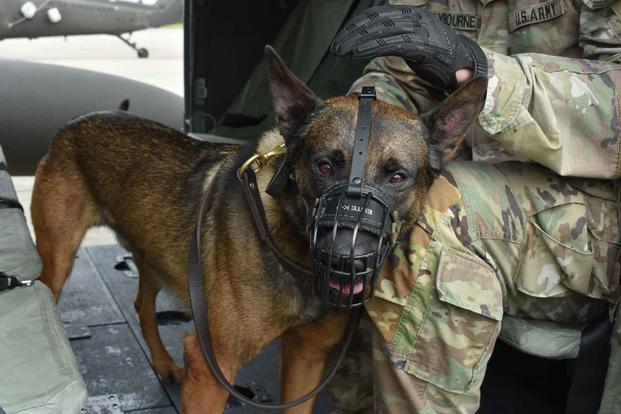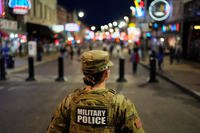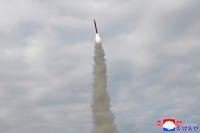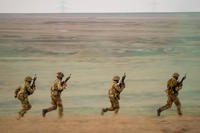The Army revamped its health and wellness program for soldiers in 2020, dubbing it "Holistic Health and Fitness," or H2F. There, the service got into doctrine on how soldiers should take care of themselves, including proper sleep, nutrition, exercise and mental health.
Now, the Army is doing the same for its working dogs, a force of about 500 pooches in the conventional units.
"You'll see treadmills in kennels for the dogs now, and we're doing different warmup and cooldown drills," Sgt. Maj. Viridiana Lavalle, the Army's military working dog program manager, told Military.com on Tuesday during the annual Association of the United States Army conference in Washington, D.C. "We talk about soldiers being athletes; the same goes for military working dogs. They absolutely are military athletes."
Read Next: Troops Suing Defense Department over Vaccine Mandate Reach $1.8 Million Settlement
The so-called "Canine H2F" is still in the development stages, Lavalle explained.
"It starts with nutrition, quality of life, kennel environments, handler assignment conditions and then physical conditioning," she said.
Working dogs typically get playtime and time set aside to socialize with other dogs, but the goal of the Canine H2F is codifying those routines, because there currently are few military-wide standards for fitness training and mental health care for dogs.
Working dogs often get exercise through hours of daily work, but the new program in development aims to outline specifics on physical training beyond those hours working or regular training.
The program will also introduce dog beds that help with mobility support; an expanded portfolio of treats and toys; and more accommodating kennels, which could include nature sounds and music to relax dogs.
A key part of the effort to improve canine quality of life in the Army will be having dogs move with their handlers. When a soldier is assigned to a new installation, the dog will come too. Such moves would streamline the training and various certifications handlers must now get when they show up to a new unit and are assigned a new dog.
A military working dog can get a new handler every two to three years. In some cases, a dog will work with only one handler and then be ineffective, or even aggressive, when the handler they've bonded with for years moves on in their career.
The issue has also impacted the morale of those handlers who grow attached to specific working dogs.
"This allows us to decrease behavioral issues, increase and improve quality of life for the military working dogs," Lavalle said.
Sgt. Jonathan Bouchard moved to Joint Base Myer-Henderson Hall, Virginia, from Joint Base Lewis-McChord, Washington, with his military working dog Harry. They are among the first handler and dog pairs who have moved to a new base together under the new policy.
"I had really attached to him," Bouchard said. "And the opportunity now is that I can stay with this dog and advance him more. I came here; I'm automatically [starting] missions and real work with him."
As the Army pivots from the past two decades of fighting insurgencies and toward conventional war, one key change expected in dog training is preparing them to work in subways, sewer systems and other subterranean features seen in large urban areas.
Those underground environments are much more claustrophobic than dogs are used to and can affect their abilities, such as hearing and smell.
"Where we go underground and be able to work effectively, those are some of the hurdles,"
Dave Reiter, Military District of Washington military working dog program manager, told Military.com.
Working dogs play critical security roles in searching for drugs, people and bombs. Throughout the Global War on Terror, the dog handler profession in the conventional Army, which includes 595 troops, saw major leaps in technology. Dogs, like soldiers, are issued boots to protect their paws while deployed in harsh conditions, or just conditions at home where hot pavement in the summer can be painful.
Dogs also now have their own eye and ear protection, which handlers are able to use to give commands remotely. In some cases, dogs can be equipped with cameras to provide reconnaissance on building interiors and be directed on where to look.
-- Steve Beynon can be reached at Steve.Beynon@military.com. Follow him on X @StevenBeynon.
Related: Congress' Move to Scrap the ACFT Sparks Outcry from Army Leadership














